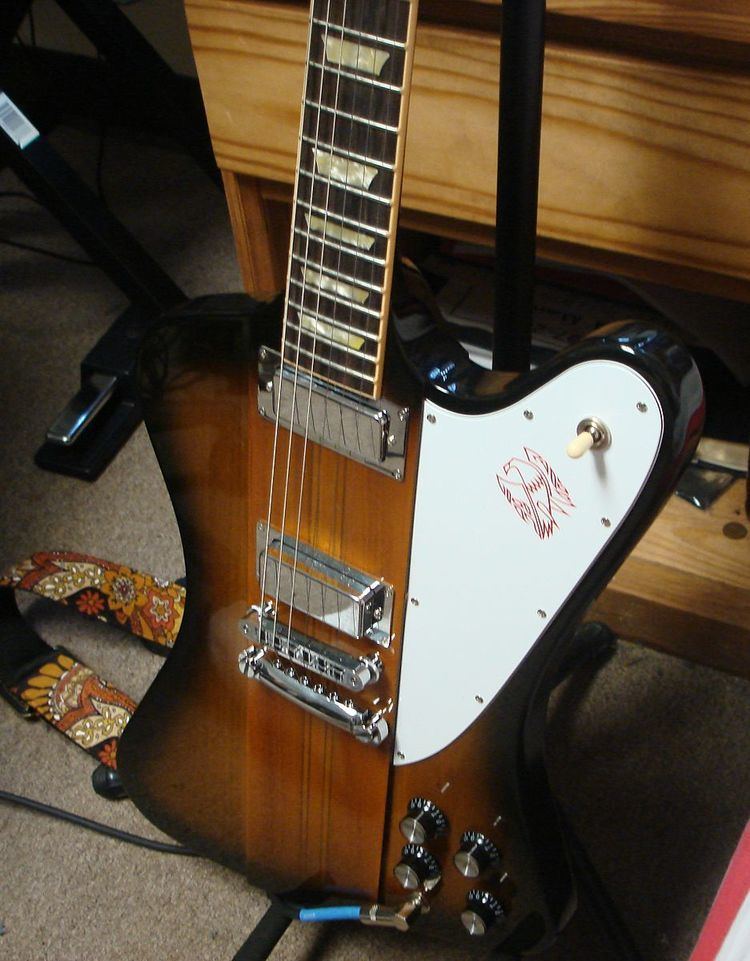Manufacturer Gibson Body type Solid | Period 1963 — present Scale 24.75" | |
 | ||
Neck joint Through-body; some models have set necks | ||
The Gibson Firebird is a solid-body electric guitar manufactured by Gibson from 1963 to the present.
Contents
History
The Gibson Guitar Corporation released several new styles during the 1950s to compete with Fender's solid-body instruments, such as the Telecaster and Stratocaster. After success with the Les Paul in the 1950s, Gibson's popularity began to wane in the 1960s. Fender's colors, shapes and multiple pickups were endorsed by notable guitarists. Gibson's guitars, most of which were hollow or semi-hollow designs, seemed old-fashioned. Coupled with higher prices, this contributed to a decline in sales.
Gibson had made forays into radical body shapes - the Flying V and Explorer in the 1950s - which met limited initial success. The president of Gibson, Ted McCarty, hired car designer Ray Dietrich to design a guitar that would have popular appeal. Under Dietrich, the Firebird took on the lines of mid-50s car tailfins. Dietrich took the Explorer design and rounded the edges. The most unusual aspect is that the guitar is "backward" in that the right-hand (treble) horn of the body is longer than the other. Thus, the original Firebirds were unofficially referred to as "reverse". The Firebird looks like an Explorer with softer "points," or maybe a reverse Fender Jaguar or Jazzmaster.
The Firebird is the first Gibson solid-body to use neck-through construction, wherein the neck extended to the tail end of the body. The neck itself is made up of five plies of mahogany interspersed with four narrow strips of walnut for added strength. Other features were reverse headstock (with the tuners on the treble side) and "banjo"-style planetary geared tuning keys. The special original Gibson Firebird humbucking pickup(s) - single, dual or triple - were smaller footprint versions of standard Gibson humbucking pickups, but were unique in that inside each of their smaller bobbins contained an AlNiCo bar magnet (standard humbucking pickups AND mini-humbucking pickups have one bar magnet that activates the 6 iron slug poles of one bobbin, and 6 iron screw poles of the other bobbin). Original Firebird pickups were also built without any specific bobbin fasteners - their bobbins (and possible "reflector" plate under the bobbins) were held onto the frame during both the wax potting process (to reduce/eliminate feedback and unwanted noise) and the solid metal cover that was soldered to the frame base. There are no screw poles on Firebird pickups. Some Firebirds from 1965 featured Gibson's single-coil P-90 pickup.
The Firebird line went on sale in mid-1963 with four models distinguished by pickup and tailpiece configurations (see below). Unlike the Les Paul and SG line, which used the terms "Junior", "Special", "Standard" and "Custom", the Firebird used the Roman numerals "I", "III", "V" and "VII". Gibson's line of Thunderbird basses is rooted in the design of the Firebird, and uses even Roman numerals ("II" and "IV") to distinguish it. From 1965 to 1969, Gibson introduced "non-reverse" models after failing to achieve marketing success with the unusual reverse-body design. Gibson had also received complaints from Fender that the Firebird headstock mirrored the Stratocaster and that the body violated Fender's design patents, with Fender threatening a lawsuit. The "non-reverse" body is a more standard double-cutaway design, with the bass horn being longer than the treble horn and the headstock having the tuners mounted on the bass side. It also had a standard glued-in ("set") neck rather than neck-through construction, as well as other, less noticeable changes in design and build. Pickup and tailpiece configuration for the V and VII were the same as the earlier "reverse" models, although the I- and III-models were now shipped with two or three P-90 pickups and plain vibratos. After a few years of disappointing sales, the "non-reverse" line was dropped. "Reverse" body Firebirds were first reissued in 1972, with a commemorative "Bicentennial" modelreleased in 1976, available in either black with gold-plated hardware or the traditional sunburst finish. The bicentennial model was distinguished by a red-white-blue logo on the white pickguard. The logo on most other models is red.
Reissues
The "reissue" Firebirds are usually based on the original reverse body design; however Gibson reintroduced the non-reverse Firebird in 2002 as a Custom Shop guitar. While prices for just about all vintage guitars have rocketed, the reverse body Firebirds are the more popular design, and command more money than the non-reverse. Many types have been released. Epiphone, owned by Gibson, also issued Firebirds.
The 2010 Standard Firebird V will not feature the classic banjo tuners but Steinberger gearless tuners, tuners with the tuning key on the back, and locking mechanisms on top of the headstock. Gibson stated that they will no longer be creating banjo tuners.
It's important to note that modern Gibson reissues of the Firebird do not use the same Firebird pickup build that was originally introduced in 1963. These new pickups do not have the same tone and output as the originals. Dissecting an original 1963 Gibson Firebird pickup reveals twin plastic mini bobbins with AlNiCo bar magnets inserted into the center of each. Most, but apparently not all, of these early Firebird pickups used a metal "reflector" plate under the bobbins and magnets that increased the pickup's inductance and those bobbins are wound with 42AWG coil wire. Recent issue Gibson Firebird pickups use ceramic bar magnets and 43AWG coil wire and no reflector plate, making for a very different Firebird pickup. Modern Firebird pickups have more output (volume), more midrange, less treble "bite" and a higher DCR reading, whereas vintage Firebird pickups have less output, less midrange, more treble "bite" and a lower DCR reading.
